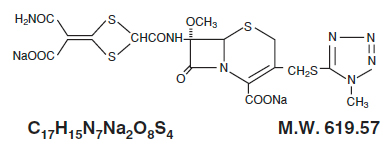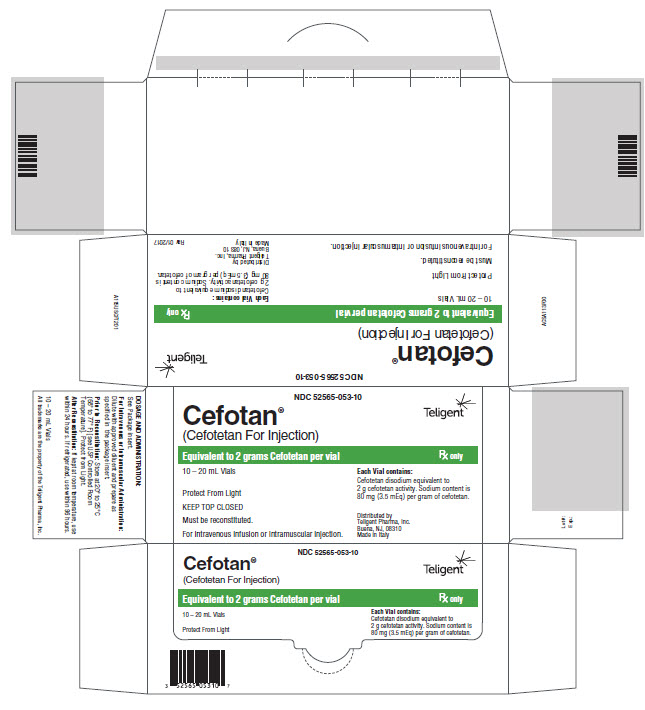Cefotan
Generic name: cefotetan
Drug class: Second generation cephalosporins
Medically reviewed by A Ras MD.
What is Cefotan?
Cefotan is a prescription medicine that is used to treat or prevent bacterial infections.
Description
CEFOTAN® (cefotetan for Injection, USP), as cefotetan disodium, is a sterile, semisynthetic, broad-spectrum, beta-lactamase resistant, cephalosporin (cephamycin) antibacterial for parenteral administration. It is the disodium salt of [6R-(6α,7α)]-7-[[[4-(2-amino-1-carboxy-2-oxoethylidene)-1,3-dithietan-2-yl]carbonyl]amino]-7-methoxy-3-[[(1-methyl-1H-tetrazol-5-yl)thio]methyl]-8-oxo-5-thia-1-azabicyclo[4.2.0]oct-2-ene-2-carboxylic acid. Structural formula:

CEFOTAN® (cefotetan for Injection, USP) is supplied in vials containing 80 mg (3.5 mEq) of sodium per gram of cefotetan activity. It is a white to pale yellow powder which is very soluble in water. Reconstituted solutions of CEFOTAN® (cefotetan for Injection, USP) are intended for intravenous and intramuscular administration. The solution varies from colorless to yellow depending on the concentration. The pH of freshly reconstituted solutions is usually between 4.5 to 6.5.
CEFOTAN® (cefotetan for Injection, USP) is available in two vial strengths. Each 1 gram vial contains cefotetan disodium equivalent to 1 gram cefotetan activity. Each 2 gram vial contains cefotetan disodium equivalent to 2 grams cefotetan activity.
Before taking Cefotan, tell your doctor:
- If you are allergic to Cefotan; any part of this medicine; or any other drugs, foods, or substances. Tell your doctor about the allergy and what signs you had.
- If Cefotan or alike drugs caused low red blood cell counts before.
This medicine may interact with other drugs or health problems.
Tell your doctor and pharmacist about all of your drugs (prescription or OTC, natural products, vitamins) and health problems. You must check to make sure that it is safe for you to take Cefotan with all of your drugs and health problems. Do not start, stop, or change the dose of any drug without checking with your doctor.
What are some things I need to know or do while I take Cefotan?
- Tell all of your health care providers that you take Cefotan. This includes your doctors, nurses, pharmacists, and dentists.
- Have blood work checked as you have been told by the doctor. Talk with the doctor.
- Avoid alcohol and products that have alcohol in them while taking Cefotan and for at least 72 hours after your last dose. Drinking alcohol or taking products that have alcohol in them, like some cough syrups, may cause flushing, sweating, headaches, and fast heartbeat.
- If you have high blood sugar (diabetes) and test your urine glucose, talk with your doctor to find out which tests are best to use.
- Do not use longer than you have been told. A second infection may happen.
- This medicine may affect certain lab tests. Tell all of your health care providers and lab workers that you take Cefotan.
- If you are 65 or older, use Cefotan with care. You could have more side effects.
- Tell your doctor if you are pregnant, plan on getting pregnant, or are breast-feeding. You will need to talk about the benefits and risks to you and the baby.
How is Cefotan best taken?
Use Cefotan as ordered by your doctor. Read all information given to you. Follow all instructions closely.
- It is given as a shot into a muscle or as an infusion into a vein over a period of time.
What do I do if I miss a dose?
- Call your doctor to find out what to do.
What are the side effects of Cefotan that I need to call my doctor about immediately?
WARNING/CAUTION: Even though it may be rare, some people may have very bad and sometimes deadly side effects when taking a drug. Tell your doctor or get medical help right away if you have any of the following signs or symptoms that may be related to a very bad side effect:
- Signs of an allergic reaction, like rash; hives; itching; red, swollen, blistered, or peeling skin with or without fever; wheezing; tightness in the chest or throat; trouble breathing, swallowing, or talking; unusual hoarseness; or swelling of the mouth, face, lips, tongue, or throat.
- Any unexplained bruising or bleeding.
- Not able to pass urine or change in how much urine is passed.
- Fever or chills.
- Sore throat.
- Seizures.
- Vaginal itching or discharge.
- Diarrhea is common with antibiotics. Rarely, a severe form called C diff–associated diarrhea (CDAD) may happen. Sometimes, this has led to a deadly bowel problem (colitis). CDAD may happen during or a few months after taking antibiotics. Call your doctor right away if you have stomach pain, cramps, or very loose, watery, or bloody stools. Check with your doctor before treating diarrhea.
- Rarely, a very bad blood problem called hemolytic anemia has happened with Cefotan. Sometimes it has been deadly. The chance of getting hemolytic anemia may be higher with Cefotan than with other drugs like this one. Call your doctor right away if you feel very tired or weak, or if you develop dark urine or yellow skin or eyes while you are using Cefotan or within 3 weeks after you stop it.
What are some other side effects of Cefotan?
All drugs may cause side effects. However, many people have no side effects or only have minor side effects. Call your doctor or get medical help if any of these side effects or any other side effects bother you or do not go away:
- Diarrhea.
These are not all of the side effects that may occur. If you have questions about side effects, call your doctor. Call your doctor for medical advice about side effects.
You may report side effects to the FDA at 1-800-332-1088. You may also report side effects at https://www.fda.gov/medwatch.
If overdose is suspected:
If you think there has been an overdose, call your poison control center or get medical care right away. Be ready to tell or show what was taken, how much, and when it happened.
How do I store and/or throw out Cefotan?
- If you need to store Cefotan at home, talk with your doctor, nurse, or pharmacist about how to store it.
Label
Principle Display Panel

SRC: NLM .
